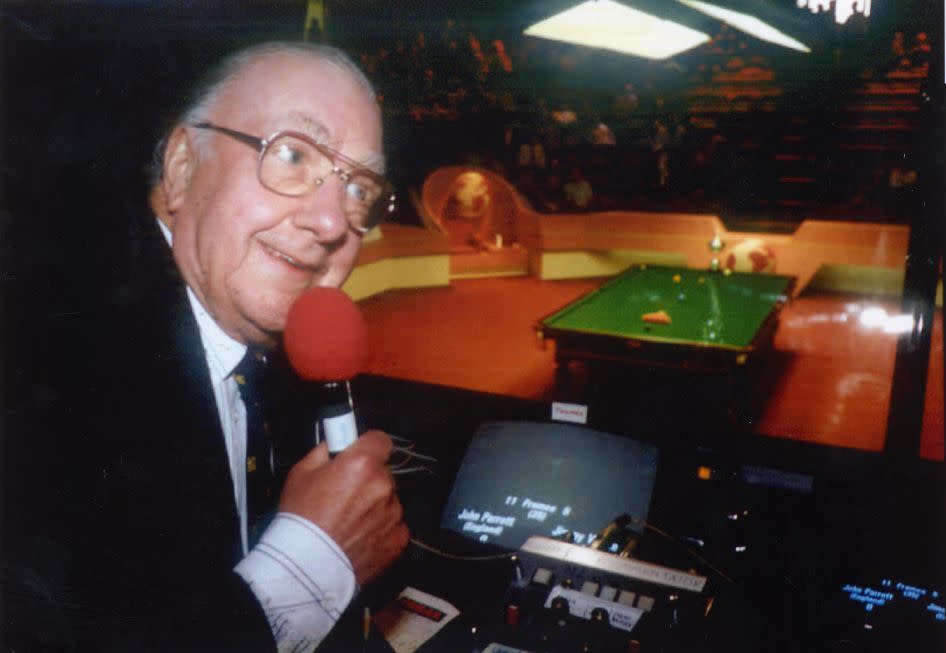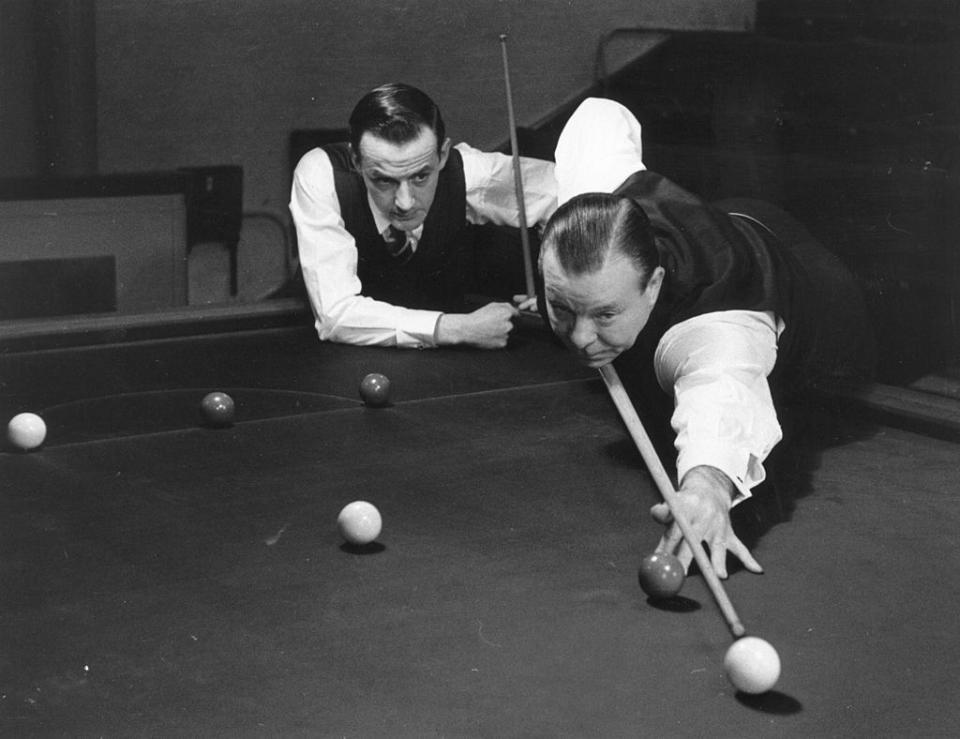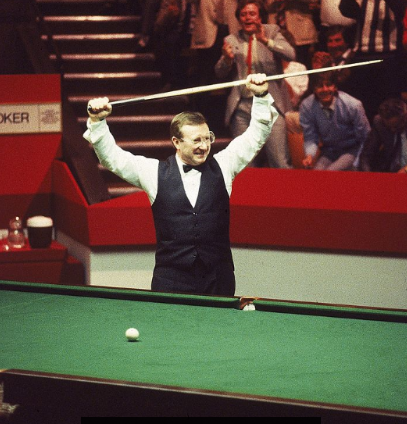yahoonick
In our weekly series, Yahoo Sport’s Nick Metcalfe features a famous voice of sport. With the UK Championship in full swing, the BBC snooker commentator Ted Lowe is the latest to go under the spotlight.

We’ve already covered many wonderful broadcasters in this series. But I don’t think any have had as famous a nickname as the man we’re profiling this week. Throughout snooker and far beyond, Ted Lowe was simply known as “Whispering Ted”.
Snooker has been a regular feature on our television screens for half a century now. And the voice we most associate with it to this day belongs to Lowe.
He was interested in the game all his life. As a youngster he was an enthusiastic amateur player. He once wrote to the legendary Joe Davis asking him to open the club where he played.
Lowe later explained: “Behind my back, some people told him that I was a good young player so he challenged me to a game. I beat him with a four-black start and made the local news.”
In 1947, Lowe was appointed as manager of Leicester Square Hall in London. Many of the top events were held there, with Davis the top attraction. Lowe really was a jack of all trades at the venue, doing everything from introducing the players to cleaning up at the end of the day.
The BBC did occasionally show snooker in the 1950s and 1960s, particularly to fill gaps in the schedule of its flagship sports programme Grandstand, which was enjoyed by millions of viewers on a Saturday afternoon. These matches would invariably feature Joe Davis and his younger brother Fred.
Lowe had his first big break when the BBC’s regular commentator, Raymond Glendenning, turned up one day with laryngitis. Back then there was no commentary box, so Lowe described the action from among the audience. Naturally he couldn’t disturb the players, so whispered his way through commentary. Whispering Ted was up and running.
Lowe himself later recalled those days: “I was scared to death commentating on Joe Davis, who was a god to me. Of course, sitting in the crowd I was terrified they would hear what I had to say, so I started whispering. The producer loved it.”
For most of the 1960s, snooker was still shown only sporadically on television. But all that changed in 1969, when colour came to BBC2 and the programme Pot Black was devised.
Viewers of a certain age will fondly remember the show, which in many ways was snooker’s gateway into the big time. Every week, we would see two top players taking each other on in a single frame. And Lowe was the permanent commentator.
Not everybody had colour televisions back then of course. And it was during the Pot Black years that Lowe came up with a quote that instantly went down in commentary folklore.
“For those of you who are watching in black and white, the pink is next to the green.”

Willie Thorne was one player that turned professional purely to play on Pot Black: He explained: “In 1976 Ted asked me to go on Pot Black. At the time I was the youngest pro in the world at 21, I said ‘I don’t think i’m ready’, but he said ‘I want you to go on there, you’re young, we need to kick start it with the young people playing’.”
In time, TV companies came to see that snooker had a loyal following, and another big moment for the sport came when the World Championship moved to the Crucible Theatre in Sheffield in 1977. For the following year’s event, the BBC showed the action live throughout the two-week tournament, and viewers were hooked.
The event threw up many memorable stories. There was an unlikely win for Welshman Terry Griffiths in 1979, the emergence of the brilliant Steve Davis, who claimed his first title in 1981, and a second world crown for the exciting and wildly unpredictable Alex “Hurricane” Higgins twelve months later.
Millions will always remember that when the Northern Irishman won the title in 1982, he cried for his baby daughter to be brought over to see him. Snooker was beginning to resemble a soap opera. “Dallas with balls,” as the promoter Barry Hearn put it.
In truth, nearly everyone was a character in those days. There was Jimmy “Whirlwind” White, Kirk Stevens with his white suits, Dennis Taylor with those upside down glasses. Even the more predictable players had nicknames. Cliff Thorburn was “The Grinder”, Eddie Charlton simply “Steady Eddie”.
Throughout all those long days and nights in Sheffield in the spring, Lowe was our regular companion. As he was for other tournaments that became familiar events in our sporting calendars, like the UK Championship and the Masters.
He was very much seen as the “voice of snooker” by fans everywhere. As 1979 UK champion John Virgo put it: “Every sport needs a voice. Cricket had its John Arlott, Wimbledon had its Dan Maskell, we had Ted Lowe. He gave it that presence.”
Lowe was a fixture in the commentary box whenever snooker was shown on the BBC, whispering his way through the slow burning drama. I used to love the way he referred to players as “stars”, as well as his obvious respect and love for the game.
He was very much from the old school of commentary in that he tended to speak sparingly. Today, nearly every shot is analysed by commentators, but with Lowe you could often expect long periods of silence.
“Ted didn’t try to analyse, he was the colour man,” Davis explains. “What every sport needs is someone to paint the pictures, and Ted was great at that.”
The most famous moment in snooker history came in 1985, when 18.5 million viewers tuned into BBC2 after midnight to see an incredible climax to the world final between Davis and Taylor. The drama and tension that night was extraordinary, and Lowe’s words were very much part of the whole show.
A simple amazed “No” when Davis failed to cut the black in to win the deciding frame was enough to stick in the memory, followed by a “this is really unbelievable” as Taylor lined himself up to pot the black for the most famous of victories.
“He’s done it. Dennis Taylor for the first time becomes world snooker champion. A fabulous picture of a very happy and popular man.”

Snooker was riding so high at one stage, it was almost threatening the dominance of football (no, really). The stars of the game even had a hit record, “Snooker Loopy”.
It was inevitable as the years went on that the sport would slip down from those outrageous peaks of the mid 1980s. But snooker could still always be relied upon to attract very healthy TV audiences, especially for the four world finals between the young Scot Stephen Hendry and crowd-pleaser White.
In Hendry’s early days, Lowe said: “They call him the wonder bairn of Scotland.” As for the Englishman, he once commented: “A little pale in the face, but then his name is White.”
Lowe was the link between snooker’s past and present. And he carried on doing the job until the 1996 World Championship, where Hendry beat Peter Ebdon in the final to win his sixth Crucible title.
Lowe did give viewers a pleasant surprise when he returned for a brief cameo in the BBC commentary box during the 2005 final between Shaun Murphy and Matthew Stevens. But otherwise that famous voice was heard no more.
Lowe died in 2011 at the age of 90. The audience at the Crucible for the world final between John Higgins and Judd Trump stood to applaud in tribute.
Davis said simply: “He was part of our lives. Every player will at some stage have been touched by his words.”
It’s true, you know. Lowe, like so many broadcasters in this series, was part of our lives. Always there in the corner of the room. A comforting background noise. It’s another voice we’ll always remember with great fondness.


